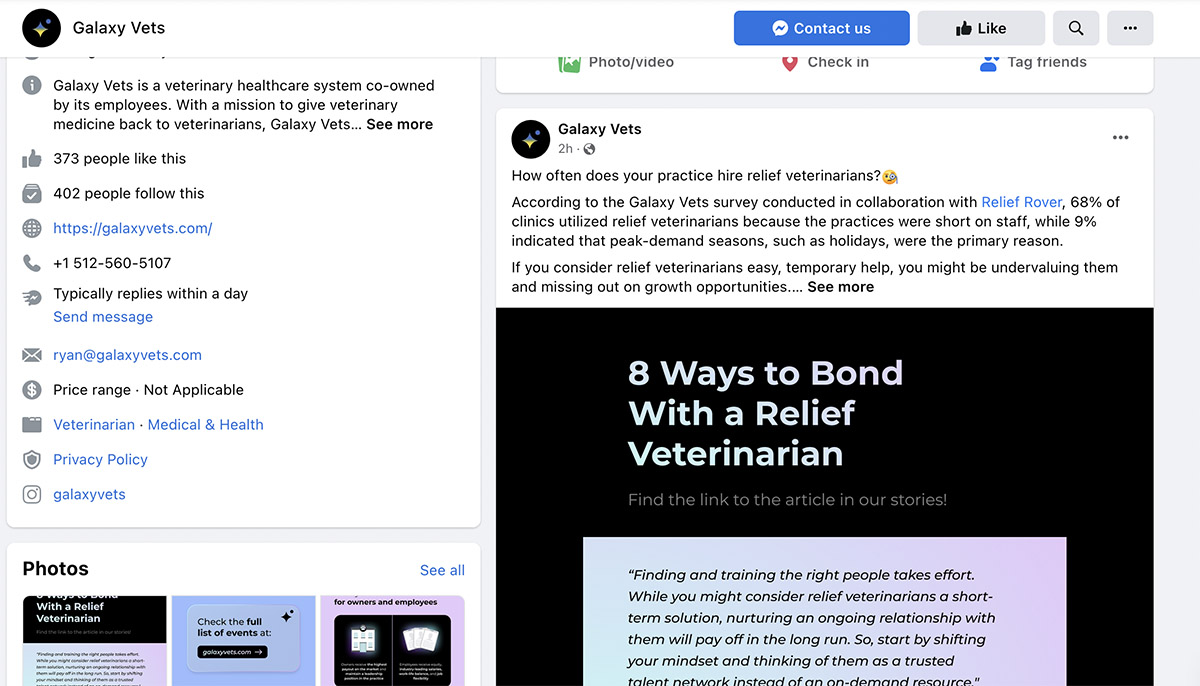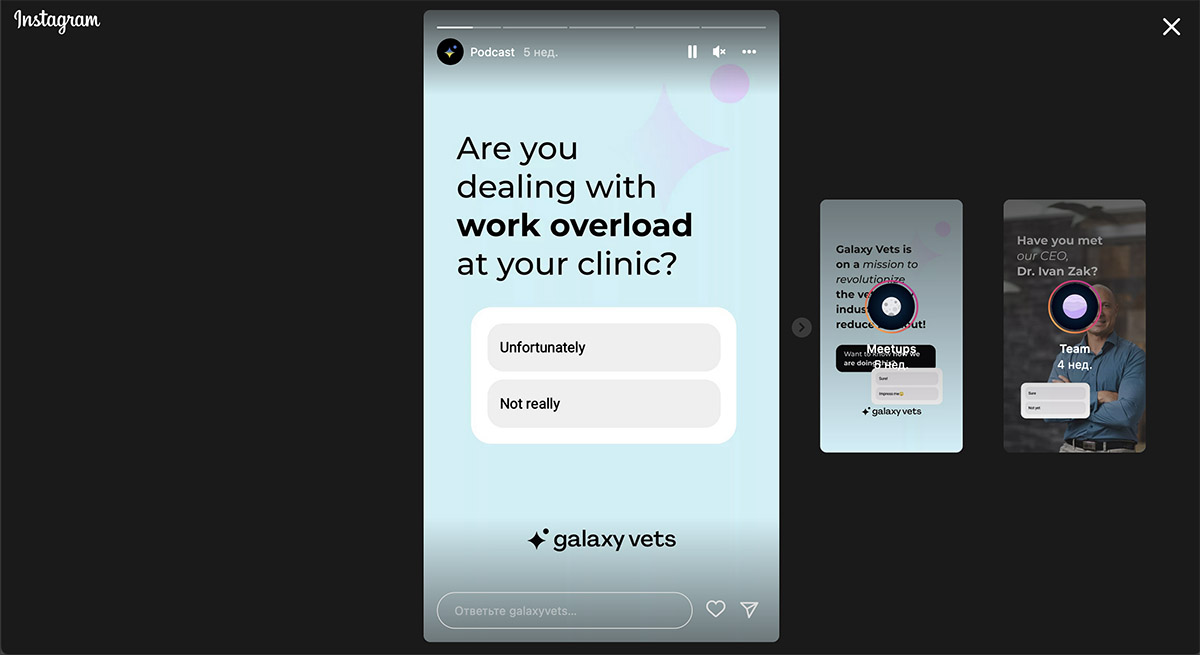Introduction
Social media is the primary communication channel with today’s customers. Nearly every American uses some form of social media; there are 180 million active Facebook users in the United States alone, and almost 3 billion globally. Americans love YouTube even more, with 210 million active users at the beginning of 2022. Similar numbers also show Instagram, TikTok, and other social media supplanting traditional media.
You can’t reach your clients without the help of social media. Let’s dive deep into the world of social media marketing (SMM) and determine its benefits for the veterinary industry. We’ll review common terms, commercial strategies, and best practices. Finally, we’ll provide you with a full guide on how to launch successful social media marketing for your veterinary practice.
Thinking about selling your veterinary practice?
Social media marketing essentials
What is SMM?
A precise definition of social media marketing is needed to make the best use of modern technology and differentiate SMM from more traditional types of marketing.
Social media marketing involves any marketing that occurs on social media.
Marketing itself refers to activities promoting products or services. SMM is simply a set of activities on popular social media channels. Successful SMM results in an increase in sales and awareness of your product or service. It also builds engaged consumer communities and even provides helpful customer service via easily accessible social media platforms.
The difference between SMM and online reputation management (ORM)
For many veterinary practice owners, there is no difference between SMM and Online Reputation Management (ORM). They see no difference between advertising on Facebook and accumulating positive reviews on Google My Business or Yelp. These two terms, however, differ in important ways.
Yes, these two terms are having partially intersecting areas of responsibility; SMM has its own component of online reputation management. However, these two strategies have completely different goals, tools, and approaches.
For example, ORM involves specific rules of communication when responding to negative reviews. It also involves clever strategies like parking the negative reviews under a batch of positive or neutral reviews. The goal of ORM is to hide and neutralize negative reviews while highlighting the positive ones. On the other hand, SMM mainly seeks to elevate your brand in the eyes of consumers, especially those who haven’t heard of you before. It makes it possible to appeal to users’ complaints and discuss them with them rather than just reply somewhere in Google My Business.
Popular social media platforms
Facebook
This behemoth deserves the first mention. The main advantage of Facebook is its incredible user base. According to Kepios’s Quarterly Digital Briefing, Facebook has 3 billion users. It’s easy to find people across all geographic areas of almost any age, behavior, profession, income level, or interests. Best of all, Facebook already has many veterinarian groups and pages which can be used as sources of new customers.

Here’s what you can do on Facebook in 2022:
- Create your business page and add helpful data for customers (e.g., address, description of services, or special offers)
- Attract new users and communicate with them
- Nudge users to react to your content
- Involve users in generating their own content that bolsters your brand
- Get positive client feedback
- Overcome reputational issues
- Research your competitors and their activity
- Use efficient paid advertising features
Instagram
Instagram was launched in 2010 as an advanced photo-sharing app. Since then, it was acquired by Facebook and then evolved into one of the most popular social media sites focused on pictures and videos. By January 25, 2022, about 1.221 billion out of 4.2 billion social media users (over 29%) used Instagram at least once a month. The United States has the second-biggest Instagram audience, with about 160 million monthly active users.
Instagram offers the same paid advertising options as Facebook and uses the same ad management software tool. Stories – short videos with the text attached, disappearing after 24 hours – are one of the most powerful features of engagement, Reels (up to 1-minute long videos often followed by trending music) is the most powerful if we speak about reach. Instagram also offers several other features like profile-based landing pages or even entire product catalogs.
Focused fully on video content, YouTube is now the second most popular social media network globally. What’s less known is that YouTube Search is the second most popular search engine on the planet. Content is widely available without account registration, making the platform popular among those who aren’t using any other social media. YouTube allows you to reach an audience that isn’t covered by other marketing channels.
The list of marketing actions available on YouTube includes:
- Creating the channel (a form of account registration)
- Filling in the profile details
- Adding videos and textual descriptions
- Commenting on other videos and responding to user comments
- Liking and disliking videos and comments to make them more or less prominent
- Paid advertising in the form of contextualized ads shown before a video plays
A micro-blogging platform that launched with a modest 140-character limit for each post, Twitter expanded the limit in 2020, making it possible to attach lengthy statements and share links with detailed descriptions. Twitter was also the place where #hashtags came into being. These hashtags allow for the easy promotion of ideas or content on Twitter. It’s a very high-paced platform that expects a lot of engagement from its users.
#Veterinary professional oaths should incorporate the concept of well-being! Do you agree?
— Dr. Ivan Zak (@IvanZak) January 26, 2022
Please sign & share: https://t.co/EEVCrk5yEn#ISwearToSelfCare #CareForPetsCareForVets#burnout #vetmed #veterinarian #veterinarytechnician #mentalhealthawareness@AVMAvets pic.twitter.com/lZqg9JOGgB
Twitter offers free and paid promotional tools; corporate profile creation, promoted tweets and hashtags, post scheduling, and business entity verification all help you elevate your brand. It requires more than a short tweet to succeed, but Twitter fosters great user engagement and lets you build a loyal online following.
The latest social media darling started in 2016 and now has about a billion users worldwide. Its motto is “Make Your Day.”. TikTok focuses on short, mostly entertaining videos created by users. From the very beginning, it was rather popular among children and young adults. These days, the audience is becoming more mature and mainstream, with popular and serious topics garnering more attention. Veterinary medicine is one of them.
@drtom83 #drtom #veterinarian #fyp #veterinariansoftiktok #dogsofttiktok #viral #vetmed #foryou #vetlife #animaldoctor #dog #compassion #trust #love @goclove @wearfigs @greeniesbrand @gma ♬ Chasing Cars – Boyce Avenue
TikTok offers a pretty standard set of free and paid promotional tools. Several veterinarians have rather popular TikTok accounts: Dr. Thomas Hamilton, AchinForBlakin, Dr. Lindsay Butzer. From adorable videos of people’s pets to helpful advice related to animal health care, TikTok is a great way to create customized videos that appeal to a younger clientele.
Reddit
Stylistically unique from other platforms, Reddit claims to be “the front page of the internet.” The platform is highly social and built for virality. Reddit users generate and share all the content here, often segmenting themselves into unique communities with a specific focus. There are already thriving veterinary communities on Reddit, where users can share content and ideas with one another easily, “upvoting” comments and posts that are popular so they go viral.
Reddit lets users create niche group pages called “subreddits” to post in, and lets users join existing subreddits that are popular. The audience is highly suspicious of self-promotion attempts and prefers organic posts which exude authenticity. That’s why Reddit requires much effort in “account karma development,” or the accruing of upvotes that convince the community you’re a legitimate account. The platform also offers paid possibilities, unique targeting tools, and several advertising types.
Popular veterinary subreddits are already plentiful; everyday users can ask veterinary professionals specific questions about their pets on r/AskVets, which has over 150,000 users, or talk shop in niche groups like r/Veterinaryprofession, where students and experts gather to discuss the specifics of the veterinary trade.
Benefits of social media marketing for your veterinary business
When creating your marketing strategy, it’s important to set the right goals and focus on the best platforms for your business. Every major social media platform has plenty of users, but not all of them are interested in your content. It helps to set priorities in order to get the most results with the least effort. So, what are the benefits of SMM for your veterinary business?
- SMM offers a huge user base
As we’ve said before, the numbers of users of different social media platforms are really huge. Only search giants like Google can offer at least a similar scale of reach: 3 billion for Facebook (Meta), 2 billion for YouTube, 1.13 billion for Instagram, 1 billion for TikTok, 430 million for Reddit, and a modest 217 million for Twitter. Content that starts on YouTube, Twitter, or Reddit can easily go viral and become the focus of more traditional news coverage, too.
- SMM provides a diverse toolset to reach your audience
There are tons of proven mechanics for promoting your business on social media. While some may prove to be inefficient for your practice, you can always find others that will be helpful. The trial and error method is the only option for finding the fit here, as the best way to succeed is by targeting a niche audience.
- SMM offers both free and paid opportunities
Almost all businesses are doing their best to promote their products and services for free to the fullest extent possible. At the same time, social media platforms are seeking ways to get more revenue from users. As a result, each social media platform combines different paid and free promotional features to balance its content with the user’s demand. Whether you’re marketing on a budget or seeking to blow the competition away with cash, social media will help you elevate your brand.
- SMM has incredible distribution speed
Gigantic user bases make it easy for social media users to attract attention at the speed of light. For example, imagine you’re selling any popular good or service for an attractive price. Assume that the market you’re operating in is big enough. If you have the right budget, you can set up an ad campaign on Facebook and attract hordes of customers within hours or even minutes instead of days. All you need is the right budget and an attractive message.
- SMM boosts SEO
There are two ways social media improves your search engine ranking:
- The first one is link building. The links from social media, as long as users react positively and actively enough, help index new posts faster and gain better positions in search results.
- The second way is to boost the behavioral factors. Users from social media follow the link and spend their time reviewing your website. If the link is relevant enough to their interests, they spend more time on your website, visit more pages per session, and browse through interlinked pages. These are positive signals to search engines, helping to increase your search engine results page (SERP) positions.
- SMM helps generate referrals and viral traffic
Users of social media love to communicate with each other. Liking, sharing, and commenting are the main social activities used on different platforms. For active social media users, a piece of content they consider awesome is quickly shared with their followers. As a result, the most engaging pieces of content can become viral and spread rapidly among many users without any financial effort. Social media virality can even drive traditional news coverage if you reach a certain level of popularity.
- SMM offers advanced paid advertising capabilities
Social media platforms almost always offer cutting-edge tools to maximize a return on your investment. Most platforms let you target users based on geography, interests, age, gender, language, profession, and other demographics. Some platforms offer even hyper-focused capabilities that ensure your ads are presented to certain accounts susceptible to your messaging.
Reach and engagement
There are two main metrics that each social media specialist must monitor above all others. The first one is a reach – the number of users who viewed your post or ad. Reach can be mistaken for impressions – the number of views your content received(one user can view it more than once).
The second metric is engagement – the number of social actions users took in reaction to your post or ad. Likes, shares, upvotes, retweets, and comments are all examples of engagement with a post.
Two main communication strategies – broadcasting and involvement
When a brand starts using any social media, they choose a strategy to bolster user engagement and ensure the virality of their posts. There are two main strategies:
- The broadcasting strategy is the most popular because it is relatively simple to execute. The company simply publishes many posts with no regard for user interaction. By blasting enough posts into the social media feeds of users, a company expects one of them to eventually attract attention on its own. This strategy is efficient for young social media platforms that are gaining popularity and are highly interested in attracting new users and new businesses. This is the “quantity over quality” model of posting. Sooner or later, all the mature platforms embrace paid promotion to elevate certain posts above others, regardless of their organic popularity.
- On the other hand, the involvement strategy is focused on attracting user interactions and generating viral reactions. Once a new post is published, the platform is monitoring the reactions of users who see this post. The more engagement a post receives, the more users it will be subsequently shown to. Succeeding with the involvement strategy requires publishing something that is interesting to users to better attract their attention. This is the “quality over quantity” model of posting.
In general, the involvement strategy is far more effective than broadcasting. If you plan to use social media for getting tangible results for your practice, we recommend focusing on user engagement. This means producing fewer posts that are nevertheless of higher quality. Take users by surprise, ride the coattails of ongoing trends, or target niche user groups with specialized content that’s sure to tickle their fancy.

Content distribution in social media
If you keep a corporate blog, social media can bolster your readership and establish a positive industry reputation for your writers and practice as a whole.
- Content seeding is planting your blog posts on different social media channels that potentially have relevant audiences. Most often it is done manually but there are both free and paid tools to automate the process of content seeding. Some social media even allows you to seed on competitors’ pages, which can be super-efficient in certain cases.
- Collaboration with influencers is also popular. An influencer is a person with a high number of loyal followers. Brands make use of this popularity to promote their content, most often on a paid or mutually-profitable basis. You can find local brand ambassadors for your practice and actively work with them to build your clientele.
- Paid distribution is another way to show your content to a wider audience. Promoted posts are more authentic than obvious advertisements, so they have more potential to garner clicks and generate organic user interest. Paid distribution is also quite affordable and can yield better results than more expensive types of advertising when done well.
User-generated content
Encouraging your followers to generate brand-friendly content is exciting and profitable. This content costs your practice nothing but quickly garners the attention of many ordinary users. Not every social media platform offers such an option. If you decide to act this way, don’t forget to establish a proper pre-moderation process to avoid mishaps.
Topics that are relevant to the veterinary industry
How do you choose a topic that will engage your audience? This is the main question for all industries that use social media, including veterinary medicine.
You can answer this question by analyzing the most popular posts of your competitors.
- Form a list of 2-3 of your best-performing competitors which offer the same services as your clinic and benefit from their social media at the same time. Focus on local competitors if you can to maximize your impact.
- Analyze their social activity and find their most popular topics and posts.
- Group these topics and posts into categories.
- Form your own list of the best-fitting topics based on the findings above. Replicate successful content after putting a unique spin on it, and watch the clicks come in!
Another way is conducting a survey. Ask your customers, who are their top influencers, what topics they like the most. And you will surely find many interesting ideas.
Audiences
Social media offers several approaches to setting up advertising audiences. The trivial approaches involve targeting audience groups based on identity parameters. Less trivial ones include creating custom audiences using ready-made contact lists, lookalike audiences, and for some social media, even using competitors’ audiences.
Paid activities
Different social media platforms offer different types of advertising.
- Promoted posts or comments: the posts or comments that mimic organic ones. Quora’s promoted answers are a good example.
- Video and image ads: advertising posts filled with different content and aimed at selling goods or services. Such ads contain calls-to-action and buttons for better conversion.
- Pre-roll and post-roll ads: short clips interrupting the organic video content. If the preroll topic is close to the topic of the main video, it has a high conversion potential.
- Contextual ads: YouTube shows this type of ad right on the videos. This type of advertising is much cheaper than pre-rolls but is often inefficient.
- Promoted stories: a unique Facebook and Instagram format of short videos disappearing in 24 hours. Users like looking at stories because there will be no second chance to see them. Sometimes promoted stories show the best conversion rates across all the placements available.
Promotional activities
Some promotional activities are not free but cannot be considered as the advertising itself. This refers to so-called activations or gaming mechanics.
This kind of promotion offers users rewards in exchange for engagement: contests, giveaways, and raffles are all examples of gamified engagement. For example, a brand offers a gift to each user who brings new subscribers to their page. Think of it as the social media equivalent of a discount in exchange for a referral. Several brands can even combine their efforts to provide better prize funds, but the users must take the required actions to qualify for rewards.

How to properly launch social media for a veterinary practice: a step-by-step guide
1. Set clear goals
First of all, you must clearly define what your practice wants to achieve. While this goal isn’t related to business financing, it gets to the heart of why you’re advertising in the first place.
So, your actions within SMM must be S.M.A.R.T.: specific, measurable, attainable, relevant, and time-bound. That’s why the following mistakes are never considered true SMM by professionals:
- Three posts a day as the only goal
- Buying bots for mocking real users
- And other similar actions with non-compatible goals
Avoid those mistakes at all costs! Staff-related (HR) goals are an exception: they don’t bring leads directly but keep your business up and running.
2. Create a set of templates and standards
One of the crucial success factors is a brand book. Your SMM activities must be consistent, be attractive to users, and be aligned with the best design practices and the rules of the social media platform you’re planning to enter. So, the brand book consists of:
- Logos
- Color schemes
- Required fonts, their colors, width, and sizes
- Templates of graphical collateral.
Always stick to your brand book to keep your SMM messaging consistent.
3. Define your target audience
The target audience of each veterinary clinic is all the pet parents within a certain range. You should determine if these people are on the social media platforms you’re planning to expand to, and consider the most effective way to reach them.
4. Research your competitors
Your chance of success is minuscule without an understanding of your competitors. Learn which veterinary practices in your area are active, and learn from their successes. You should analyze the following competition metrics:
- Number of subscribers
- Subscribers’ number change dynamics
- Posting frequency
- Quality of their content
- The average level of reach and engagement
- Most engaging posts
- Least engaging posts
- Best practices they use
- Visible mistakes
Once you get the lay of the land, see what content and posts did the best for your competitors and ideate what unique spin you can add. You’ll become the local social media trendsetter in no time!
5. Develop a content plan
The next step is to prepare your content plan. Write down what kind of content you should use to be popular with your target audience.
Define a few categories of the social media posts you’ll publish, for example, company news, jokes, animals in different circumstances, veterinary regulation changes, activations, Q&A, etc. Remember that you shouldn’t publish the same type of posts one after another. A varied content diet makes for happy users.
6. Schedule your content creation and posting
Have a monthly content plan and create a schedule for publishing. Publish on days and during times when your potential audience is the most active. Facebook has the “When Your Fans are Online” feature that helps understand the best timeframes. There are also both own scheduling tools and free Creator Studio available for Facebook business users.
You can also consider tools like Buffer, AgoraPulse, or HootSuite to add some automation level to your publishing. These let you schedule posts ahead of time so that they go online at a certain hour. This lets you spend an hour or two scheduling an entire week’s worth of posts.
7. Set the analytical tools to track your success
You must measure your results from the very beginning. It is quite hard to understand what’s going wrong at the initial stage. Always compare your results with the similar posts of your closest competitors. Monitor these metrics:
- Reach-related metrics
- Engagement-related metrics
- Audience growth rate
- Best and worst performing posts
- The conversion rate for each promotional activity
- The conversion rate for all social media
- Click-through rate (CTR)
- Bounce rate
- Cost-per-click
- Customer review rate
You can find detailed information about the social media metrics above here: 19 Social Media Metrics That Really Matter—And How to Track Them.
8. Communicate with users, analyze the feedback, and correct your strategy
Keeping in touch with your users is highly important, especially at the beginning of your SMM journey. Ask users what they like most and what they don’t. Listen to everyone but act slowly on the feedback so you account for all points of view.
The last step is continuous: you must gather the feedback, analyze it, and use it as a continuous source for changes. For better results, combine user feedback with the metrics data to make the most informed decisions.
How should you interpret the results? Focus on parting ways with bad ideas and expanding the good ones. Your clients, when visiting or calling, will praise your posts and actions on social media. This is the ultimate impact of SMM on veterinary practitioners. As a result, you’ll soon devise the best practices after a while.
Conclusion
Social media offers countless possibilities to the veterinary industry. If you’re considering SMM for promoting your veterinary practice, consider that success is highly dependent on deep research, a high level of creativity, and thorough planning. You may even want to hire a professional SMM expert to consult with.
Take care to closely monitor your metrics and invest seriously in your SMM. Otherwise, your marketing efforts may fall flat. Far too many veterinary businesses launch their own SMM projects without adequate research or professional assistance, leading to lackluster results.
Think carefully before launching SMM for your business. If you’re careful, committed, and willing to employ expert assistance, your SMM may quickly become your most effective marketing tool.
Want to find more of our publications related to technologies in the veterinary industry? Check our Learning Center.


